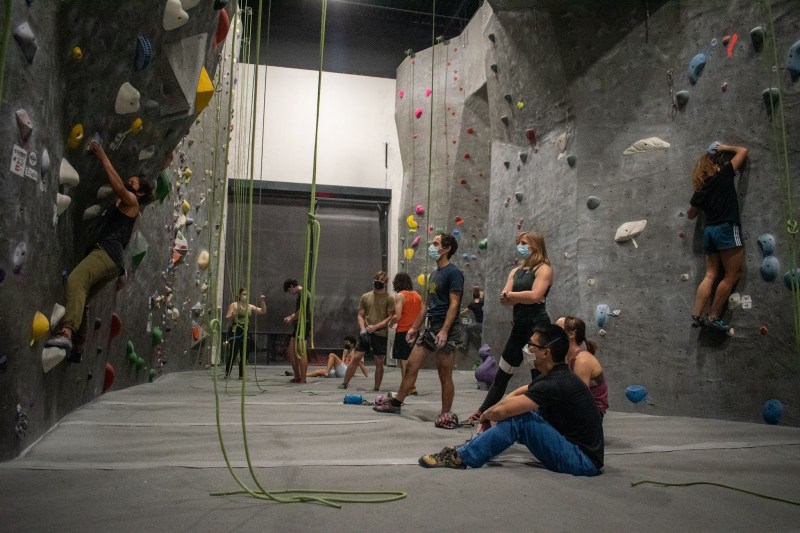When Sam Boeschen ’25 enters the rock climbing wall at the Arrillaga Outdoor Education & Recreation Center (AOERC), he finds a “feeling of total concentration.”
Boeschen, the co-captain of Stanford Climbing Team, gathers his teammates at the AOERC climbing wall to bond as they work through mental challenges in climbing workouts. The climbing community at Stanford provides “a fantastic place for students who want to learn the basics of climbing and be able to work out and learn to start to climb,” Boeschen said.
Kevin Crust echoed Boeschen on the valuable community created by rock climbing groups. Crust is a fourth-year Ph.D. candidate in physics and president of the Stanford Alpine Club, a club that meets regularly to plan outdoor trips and climb as a group. Rock climbing is “pretty inclusive and good at bringing people into the sport,” Crust said.
Even competitors are friendly with each other, wrote Leila DeSchepper ’24, who was previously the Stanford Climbing Team co-president. “Even at competitions, it’s super common to hear people on opposing teams support each other, share beta” — a sequence of moves that will get the climber to the top of the wall – “and generally hang out,” DeSchepper wrote.
Some participants said the inclusiveness of the sport was empowering. Diana Nguyen ’18, who is an avid climber, said that as a woman, rock climbing makes her “feel strong and oftentimes as strong as [her] male counterparts.”
While an important part of climbing is the social and interpersonal aspects, it also provides intense exercise. Stephanie Gady ’22 M.S. ’23, who climbs regularly, considers climbing to be “a really unique whole body workout that you would get, which is a little bit harder to achieve by just going to the gym.”
Climbing, however, is more than a physical workout. “It isn’t something that you can just muscle your way through all the time,” Boeschen said. Most routes require a substantial amount of mental preparation: before a climber even starts, they must dedicate time to figure out the proper sequence of moves, or beta.
DeSchepper wrote that she uses “both brain and body to figure out how to solve the ‘puzzle’ that each route presents.” She described the “puzzle” of a climb as a useful learning experience to manage stress in other parts of her life.
“The anticipation of waiting many hours in the isolation zone beforehand has helped me a lot with learning to calm my nerves before other types of stressful events, like final exams or interviews,” DeSchepper said.
Boeschen acknowledged the climbing community may be more accessible to some people than others. He said a possible barrier to entry is that “climbing gear costs a lot.” As a result, “the community is pretty white and pretty … socioeconomically [privileged],” Boeschen said.
Climbing gear, such as shoes, harnesses, ropes and other safety gear, are expensive, Boeschen explained. Many climbing shoes and ropes cost above $100, turning away prospective climbers, especially in outdoor climbing where people are expected to bring their own gear.
Boeschen emphasized that “the climbing community is very welcoming all around,” despite possible financial barriers.
Gady echoed Boeschen, describing climbing as “a really nice way to disconnect from classes and not worry about homework, at least for a couple hours or so.”
“Climbing is just a good way to connect with friends in a low-stakes sport environment,” Gady said.
